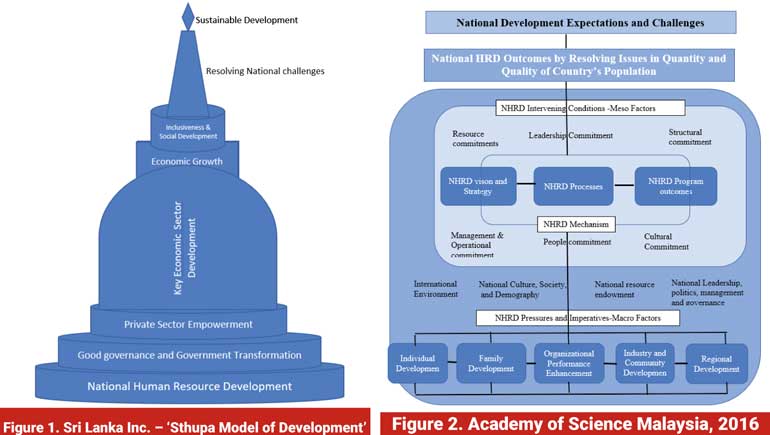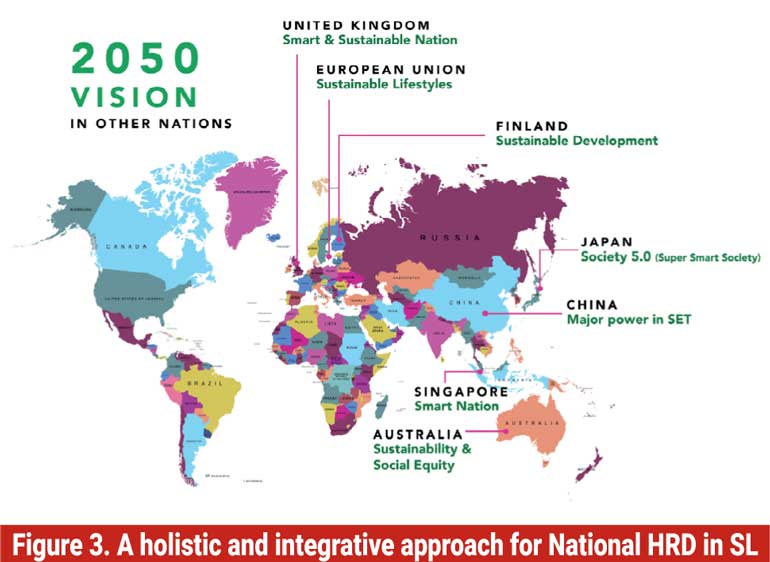Tuesday Apr 22, 2025
Tuesday Apr 22, 2025
Wednesday, 28 July 2021 00:03 - - {{hitsCtrl.values.hits}}

 With the calamities in the political arena, the social media gave rise to a concept of ‘Sri Lanka Pvt. Ltd.’ to sarcastically criticise the representation of many ‘Rajapaksas’ in the parliament. This may mean controlling the country by a family or a ‘Junta’. Or it may assume the Government to a family-owned real-estate company, that sells country’s valuable properties.
With the calamities in the political arena, the social media gave rise to a concept of ‘Sri Lanka Pvt. Ltd.’ to sarcastically criticise the representation of many ‘Rajapaksas’ in the parliament. This may mean controlling the country by a family or a ‘Junta’. Or it may assume the Government to a family-owned real-estate company, that sells country’s valuable properties.
However, for some analysts it makes a big sense and sounds a model for the country’s development. How can it be? This involves viewing the country as a large-scale corporation that assumes the country as a corporation for wealth creation by a collaborative and joint partnership of the government and the private sector. The use of this kind of model has been proven successful around the globe. I called such models here as ‘Country Incorporated (Inc.)’.
Examples for ‘Country Incorporated (Inc.)’
The close example is Malaysia. On 25 February 1983, the concept of ‘Malaysia Incorporated (Inc.)’ was first introduced by then prime minister of Malaysia, Dr. Mahathir Mohamad. This is basically a notion of managing the nation as a ‘corporate’ or ‘business entity’ jointly owned by both the public and private sectors. On the other hand, this was an ‘industrial strategy’ to forge a new symbiotic relationship and partnership between the public and private sectors to boot Malaysia’s economy.
It emulated the Japanese model of economic development that attributed a mutually benefiting and cooperative public-private partnerships and targeted state investment. In this regard, managing stakeholders become crucial to the success of this concept.
As evident in Malaysia Inc. and Japanese model of economic development, this concept has few salient features of transforming government, empowering private sector, developing key economic sectors, and grooving economic wealth.
Government should transform through good governance as the key facilitator in creating a conducive environment for the private sector to drive the economy. The government becomes the fuel while the private sector becomes the engine of economic growth.
The private sector should be empowered by extending them the needed support to access competitive investments and funds, a competitive tax regime, investment friendly business environment, efficient public services for business operations, and freedom to do business.
The core business of this model is the development of Key Economic Areas (KEAs) selecting from the economic sectors that is based on rigorous dialogues and research in the external and internal environment potentials, the country’s SWOT analysis, historic success stories, global power relationships, and the country’s vision and policy.
The immediate outcome of such public private partnerships is the economic growth to benefit both the sectors and the nation at large.
A model for ‘Sri Lanka Incorporated (Inc.)’
The world experience shows that this kind of ‘Country Inc.’ has been backed by the country’s National Human Resource Development (NHRD) with an ultimate goal of national development while resolving the country’s critical national challenges.
Therefore, the core pillars of the ‘Sri Lanka Inc.’ can be the; national HRD, good governance and government transformation, private sector empowerment, key economic sector development, economic growth, and inclusiveness and social development that guarantee the ability of resolving national challenges and achieving sustainable development. Thus, a ‘Model of Sri Lanka Inc.’ can be depicted as shown in the ‘Sthupa Model of Development’ shown in Figure 1.
The key role of National Human Resource Development (NHRD)
According to the figure, the foundation of Sri Lanka Inc. is the country’s National HRD that is holistically driven. Currently, Sri Lanka does not have NHRD. NHRD needs to be established with the country’s long-term and mid-term national policy planning. The annual budget then needs to implement the national plans. Malaysia is a very good example of having such long-term and mid-term policy planning. It launches long-term plans for more than 10 years’ period and they are cascaded to five-year plans. Since 1960, Malaysia continues its planning tradition.
Currently it is working towards its 12th five-year plan under its contemporary long-term plan that is National Transformation 2050, laid down in 2016, aiming at to be among the world’s top 20 countries in economy, happiness, and creativity and innovation. Malaysia further develops long-term and mid-term plans for its Key Economic Sectors (KESs) as well. Not only Malaysia, almost all progressing countries around the globe do such long-term and mid-term planning as depicted in Figure 2.
Holistic NHRD Model for Sri Lanka Inc.
Based on the NHRD country experiences, it is suggested to follow a holistic model of National NHRD as presented in Figure 3.
As depicted in the given figure, the holistic model integrates all levels of people operations. It starts with identifying national development expectations and challenges. In order to achieve these national development goals, the development strategies of these countries should be based mainly on people empowerment and development by resolving the issues pertinent to the quantity and quality of the whole population.
The success of an NHRD mechanism is determined mainly by its intervening conditions (meso factors) that stimulates the facilitators or hindrances towards the success or failure of the overall NHRD mechanism.
Moreover, the need for and the nature of NHRD is decided primarily by the pressures and imperatives, stimulated by the macro conditions. The country’s NHRD should link with individual development; family development; organisations’ HRM and HRD processes, and such initiatives extended to local and regional development.
The journey ahead
The political commitment becomes the crucial factor in this regard. Thus, NHRD should essentially cover executive leadership training and development, and international coaching and mentoring for the top political leaders, ministers and the members of parliaments. Unless we develop ‘professional politicians’, Sri Lanka will be further dragged behind as the poorest country in the world, created by the blunted and miserable politicians, voted by short-sighted voters.

(The writer is a Senior Lecturer Grade (I) at the University of Kelaniya Sri Lanka, former head of the Dept. of Human Resource Management, University of Kelaniya Sri Lanka, and Visiting Faculty to Lodz University, Poland. He holds the country’s first PhD in HRD, earned from ‘Universiti Putra Malaysia’ in Malaysia, in 2013. His research expertness is in National Human Resource Development, Corporate HRD and HRM, Women in Leadership, Qualitative Research Methods and Grounded Theory Research. He is an expert and a consultant, undertaking, HRM, HRD, NHRD, organisational learning, and organisational change and development projects. He co-authored international book chapters, published in springer links and Pearson publishers, and published in indexed and international refereed journals on human resource development, national human resource development, human resource management, and qualitative research methods, etc. He earned the Master of Business Administration (MBA) Degree in the Postgraduate Institute of Management (PIM), at the University of Sri Jayawardenepura, Sri Lanka in 2005. An academic innovator, introducing new course modules and syllabi in HRM and HRD, new skills development platforms for undergraduates and postgraduates, crafter of the first-ever International Student Conference in Sri Lanka (ISCB-2013), first-ever national summit on People Management since 2016, and action learning method in HRM education in Sri Lanka. Initiator for fruitful partnerships internationally and locally facilitating MoUs and undertaking special collaborative projects with international universities and local entities. Has further chaired and co-chaired international and national conferences in 2013, 2016, and 2017. He has held many administrative positions (student counsellor, career counsellor, senior treasurer, training coordinator, coordinator of MHRM program, head of department’s syllabus revision committee, etc.)
Discover Kapruka, the leading online shopping platform in Sri Lanka, where you can conveniently send Gifts and Flowers to your loved ones for any event including Valentine ’s Day. Explore a wide range of popular Shopping Categories on Kapruka, including Toys, Groceries, Electronics, Birthday Cakes, Fruits, Chocolates, Flower Bouquets, Clothing, Watches, Lingerie, Gift Sets and Jewellery. Also if you’re interested in selling with Kapruka, Partner Central by Kapruka is the best solution to start with. Moreover, through Kapruka Global Shop, you can also enjoy the convenience of purchasing products from renowned platforms like Amazon and eBay and have them delivered to Sri Lanka.
Discover Kapruka, the leading online shopping platform in Sri Lanka, where you can conveniently send Gifts and Flowers to your loved ones for any event including Valentine ’s Day. Explore a wide range of popular Shopping Categories on Kapruka, including Toys, Groceries, Electronics, Birthday Cakes, Fruits, Chocolates, Flower Bouquets, Clothing, Watches, Lingerie, Gift Sets and Jewellery. Also if you’re interested in selling with Kapruka, Partner Central by Kapruka is the best solution to start with. Moreover, through Kapruka Global Shop, you can also enjoy the convenience of purchasing products from renowned platforms like Amazon and eBay and have them delivered to Sri Lanka.